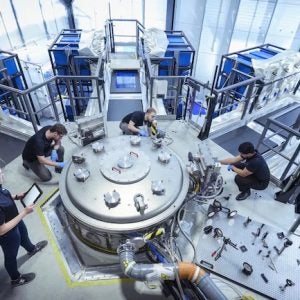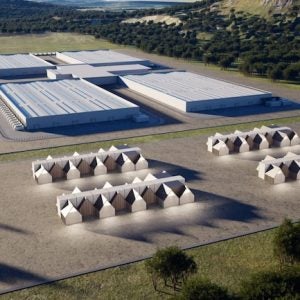 Russia’s Ministry of Energy does not expect the new BN-1200 sodium-cooled fast reactor planned for unit 5 at the Beloyarsk nuclear power plant to be built before 2035.
Russia’s Ministry of Energy does not expect the new BN-1200 sodium-cooled fast reactor planned for unit 5 at the Beloyarsk nuclear power plant to be built before 2035.
The project has not been included in the draft energy strategy of the Russian Federation up to 2035 published on the ministry’s website on 27 December.
The draft states that the installed electric capacity of Russian fast-neutron power reactors, intended to close the nuclear fuel cycle (NFC), should increase to 1.78GWe by 2035 from the 1.48GWe. Currently, the two fast reactors operating commercially in Russia are the sodium-cooled BN-600 (600MWe) and BN-800 (880MWe) at Beloyarsk units 3 and 4. The additional 300 MWe planned by 2035 in the draft strategy refers to the commissioning of a 300MWe lead-cooled BREST-OD-300 fast neutron reactor being built as part of the pilot demonstration energy complex at the Siberian Chemical Complex in Seversk, Tomsk Region, as part of the Proryv (breakthrough) project implemented by state nuclear corporation Rosatom.
The BREST-OD-300 reactor is intended for practical confirmation of the main technical solutions laid down in reactor plants with lead coolant in a closed nuclear fuel cycle, and the main provisions of the natural safety concept on which these decisions are based. The design documentation for the BREST-OD-300 reactor received approval from the Glavgosexpertiza in 2018 and construction will begin once a licence is issued by Rostekhnadzor. It is expected that the power unit will be built by 2027.
Rosatom enterprises have prepared a technical design for a BN-1200 reactor installation and materials for a BN-1200 power unit project. A joint meeting of Rosatom’s scientific and technical councils in 2017 recommended finalising these documents to improve the technical and economic indicators of the project and to develop a complete set of design documentation.
The BN-1200 will have a 60-year service life, a 60-month construction period from first concrete to the reactor start-up with a reduced cost of electricity at RUB2.35 (US3.8 cents) per kilowatt hour. Enhanced safety means, even in case of hypothetical severe beyond design basis accidents, the evacuation and resettlement of the population from areas adjacent to the nuclear power plant will not be necessary.
Previously, it was planned to begin construction of three power units with BN-1200 reactors before 2030, the first being at the Beloyarsk site. Rosatom had intended to take a decision on construction in 2017-2019 but this has now been postponed until 2021 in face of an Energy Ministry decision to cut back on reactor construction for economic reasons and to prevent an increase in electricity prices above inflation, according to Kommersant.
Rosatom will be able to spend up to RUB880 billion ($14bn) on the construction of new nuclear power units up to 2035. These funds, in particular, can be used to build new capacity at Kursk II NPP and Leningrad II NPP. Rosatom’s initial request for financing from the wholesale energy market for RUB1,160bn, but it is expected to be reduced due to the postponement of the BN-1200.
Photo: Russia's Beloyarsk nuclear power plant (credit: Rosenergoatom)






